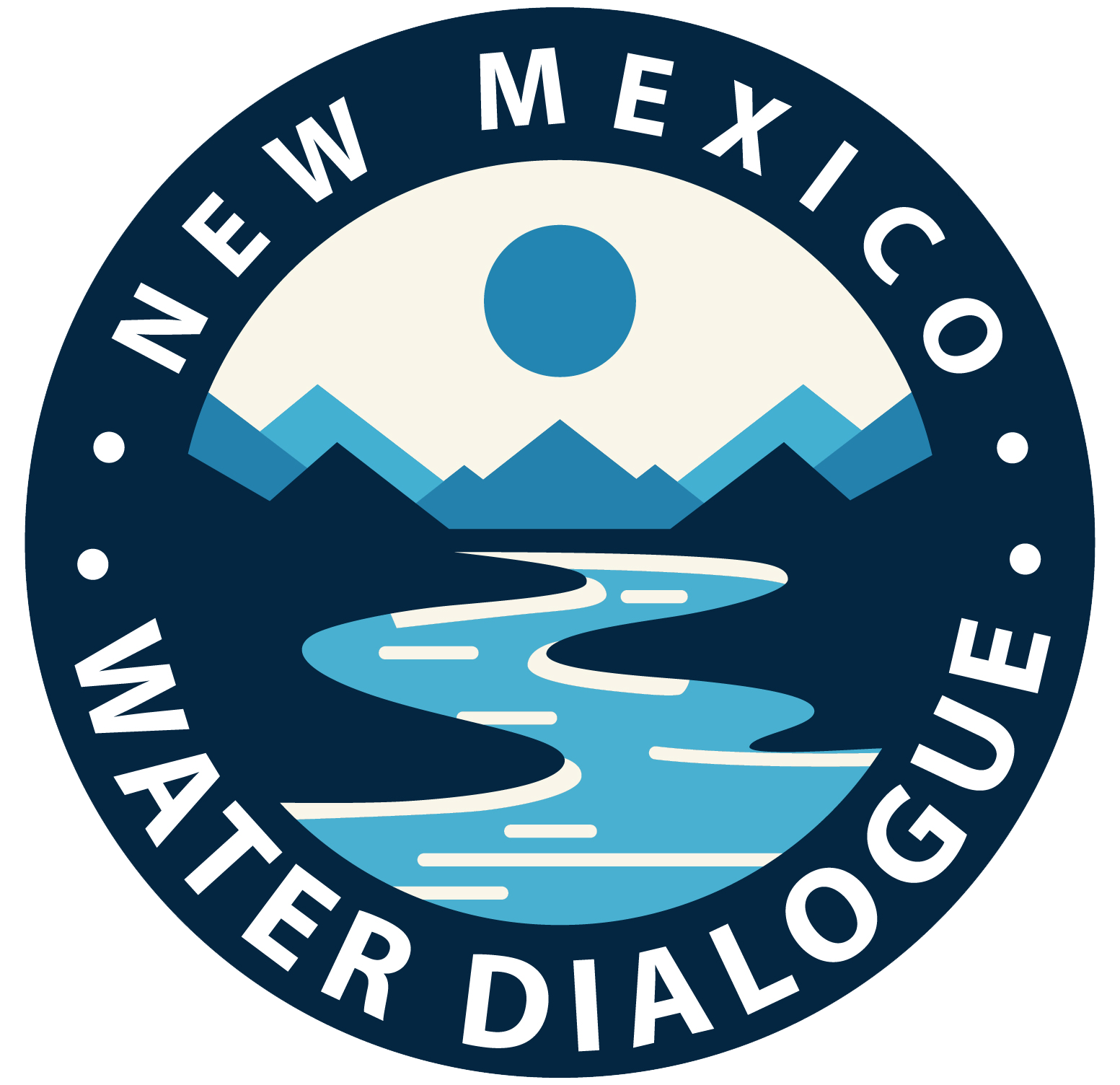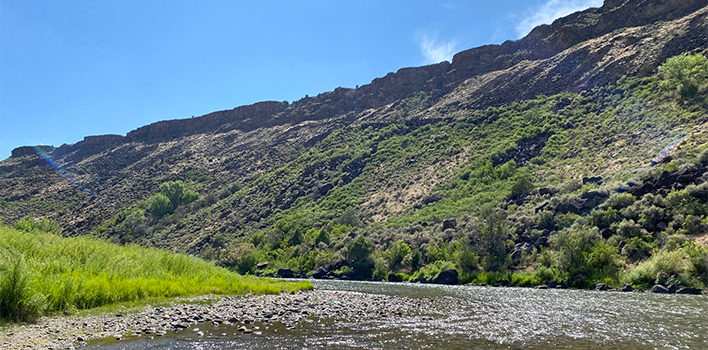New Mexico’s climate is increasingly variable, hotter, and drier. How do we respond? What steps can we take to improve our resiliency? Join in the discussion on how best to ensure water security and plan for a resilient future for New Mexico’s diverse lands and communities. The framework for making these decisions is the 50-year water plan currently being developed under the leadership of Governor Lujan Grisham, the State Engineer, and the Interstate Stream Commission.
Contents
- Facing the Complexities of Managing Water in an Arid State: Resilience and Recharge by Jeffrey Samson
- Water Resilience in New Mexico – Rolf Schmidt-Petersen by Kathy Grassel
- Emerging Policy Priorities – Melanie Stansbury by Kathy Grassel
The New Mexico Water Dialogue’s mission is “to promote the wise stewardship and assure the availability of water resources for future generations of New Mexicans.” A primary focus is to provide planning forums that are open, inclusive and democratic. Only if all New Mexico’s diverse communities are included in the process will ourstate be successful in developing a plan to manage our water resources.
Please join us for our 27th annual meeting on January 13 and 14 to participate in this effort.
Due to public health restrictions associated with the COVID-19 pandemic, this year’s event will be hosted online. We hope the online format makes it easier for more people to join us! To make the online format more enjoyable and easier to fit into your schedule, we have split the conference into 2 consecutive days, with a short, 3-hour session on January 13th (9:00-12:00) followed by two, 3-hour sessions on January 14th (morning and afternoon sessions, with a long break in the middle).
We will kick off the conference on Day 1 with welcomes from New Mexico Water Dialogue president Jason John as well as Governor Lujan Grisham (not yet confirmed) followed by a keynote by Eric Perramond, Professor of Environmental Sciences and Southwest Studies at Colorado College. We’ll end Day 1 with a panel discussion.
On Day 2, the morning session will include a keynote by Rolf Schmidt-Petersen, Interstate Stream Commission Director, followed by a panel discussion. The afternoon session will include a selection of “Table Talks,” during which you will have the opportunity to participate in small group discussions.
For full conference details, you can review and download the agenda here.
Facing the Complexities of Managing Water in an Arid State: Resilience and Recharge
By Jeffrey Samson
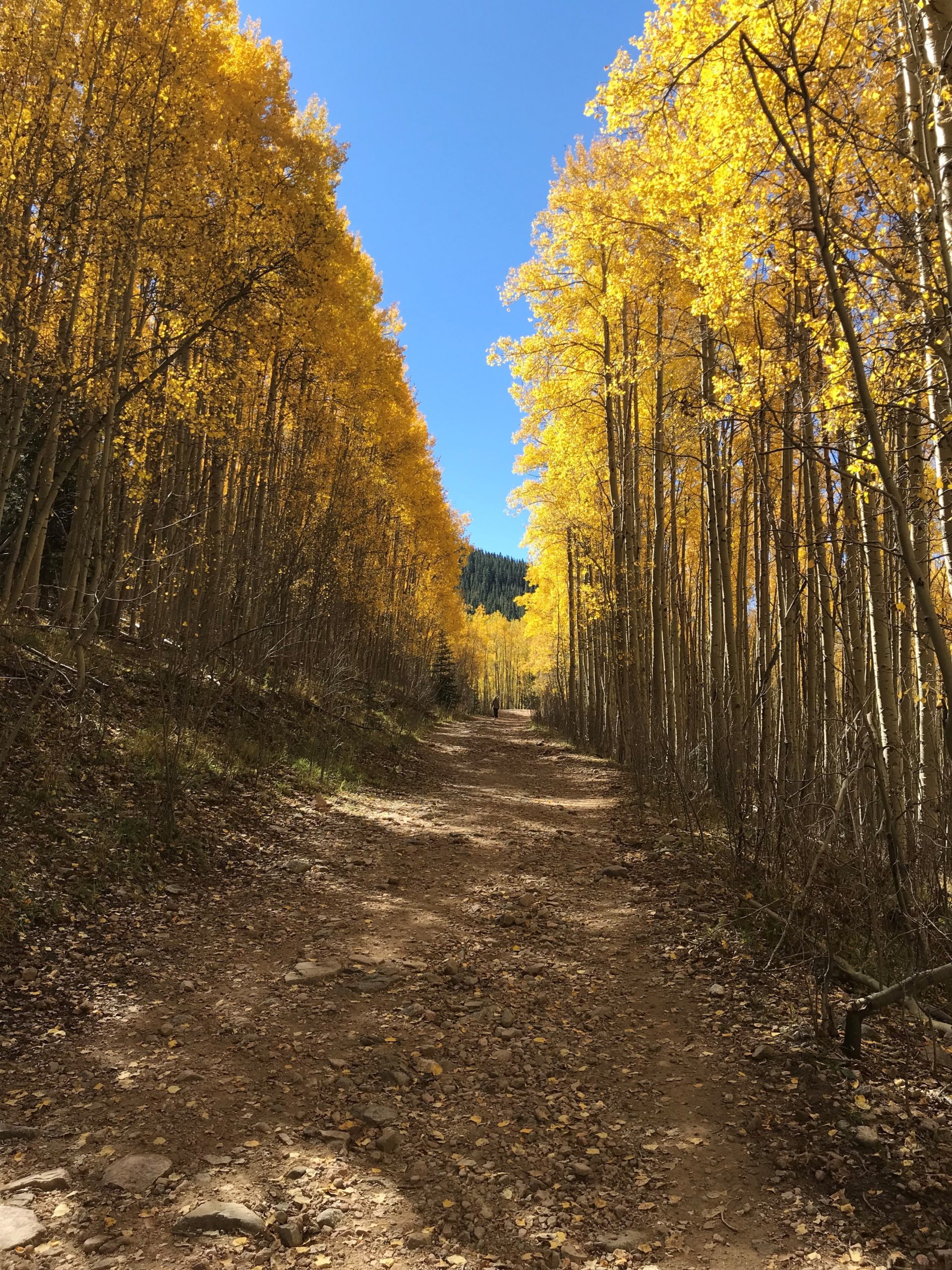
Photo by Jeffrey Samson
Prior to my current role as a water resources engineer, I was a middle school mathematics teacher in the Albuquerque Public Schools system. It wasn’t until I took engineering classes at the University of New Mexico (UNM) that I learned about the intricacies of the water cycle and the role of a State Engineer and the Interstate Stream Commission. Shortly after switching careers, I learned about the New Mexico Water Dialogue through a professor at UNM, and as a regular attendee at the annual conference and as a current board member I have listened to many of the regional experts discuss the state of science and water policy issues in New Mexico. As a practicing professional engineer working on water-related projects in contexts ranging from municipal supply to environmental remediation to industrial facility management, I have developed a sincere appreciation for water — especially the water that falls from the Southwestern skies.
In the current sociopolitical and natural environments, the complexities of the systems that moderate our daily experience seem endless, and nowhere are these more complex than in water management in the Southwest. New Mexicans depend upon the reliable delivery of clean water; unfortunately, over-allocation and climate change are leading to stress for many, including the multitude of species that similarly depend on water to survive. Fortunately, scientists have been working for years to assist water managers in understanding the impacts of water withdrawals on this desert landscape, and an essential finding of this work is the necessity of managing surface water and groundwater as a single resource. However, putting this knowledge into practice has proven difficult.
Successful management of water, whether above or below ground, requires a comprehensive understanding of the relationship between the water cycle and the landscape. The sources of precipitation in New Mexico vary throughout the year as a function of unpredictable spatial gradients related to pressure, temperature, and moisture (to name a few of the driving variables). No matter the source, once water reaches the surface there are three primary pathways for the water molecules. Depending upon antecedent conditions, the water 1) may be soaked up by the soil where it refills pores, thus increasing moisture available for an array of biota including plants and insects, while also potentially resulting in groundwater recharge depending upon location and degree of connectivity with the underlying aquifer, 2) may be returned directly back to the thirsty atmosphere in the form of evaporation or after being utilized by plants as transpiration (the combination of which is referred to as evapotranspiration), or 3) may join the delicate surface water network of streams and rivers that are like green threads woven through the desert fabric. Research has shown that these green threads are analogous to arteries for a semi-arid ecosystem, providing sustenance to nearly all animals at some point in their lives.
For millennia, the human presence in New Mexico was centered around streams and rivers and was limited in size due to the availability of water. It wasn’t until the 1940’s when the advent of large-scale groundwater pumping systems provided access to a “new” source of water that exponentially increased agricultural productivity and allowed growing communities to settle further away from surface water sources. Groundwater was initially seen as an almost limitless source with Albuquerque’s aquifer being advertised to easterners as an underground Lake Superior with hopes of drawing settlers. Fortunately, this myth has been disproven and Albuquerque has taken important steps to educate the public about the limits of our groundwater supply, while also cutting per capita water consumption in half since the 1990’s. What was once thought of as a new source is now recognized to be just the opposite. Groundwater aquifers in New Mexico store water that is tens, to hundreds, to thousands of years old, which infers that recharging these sources may require a similar timeframe, if recharge is even possible in a meaningful time scale.
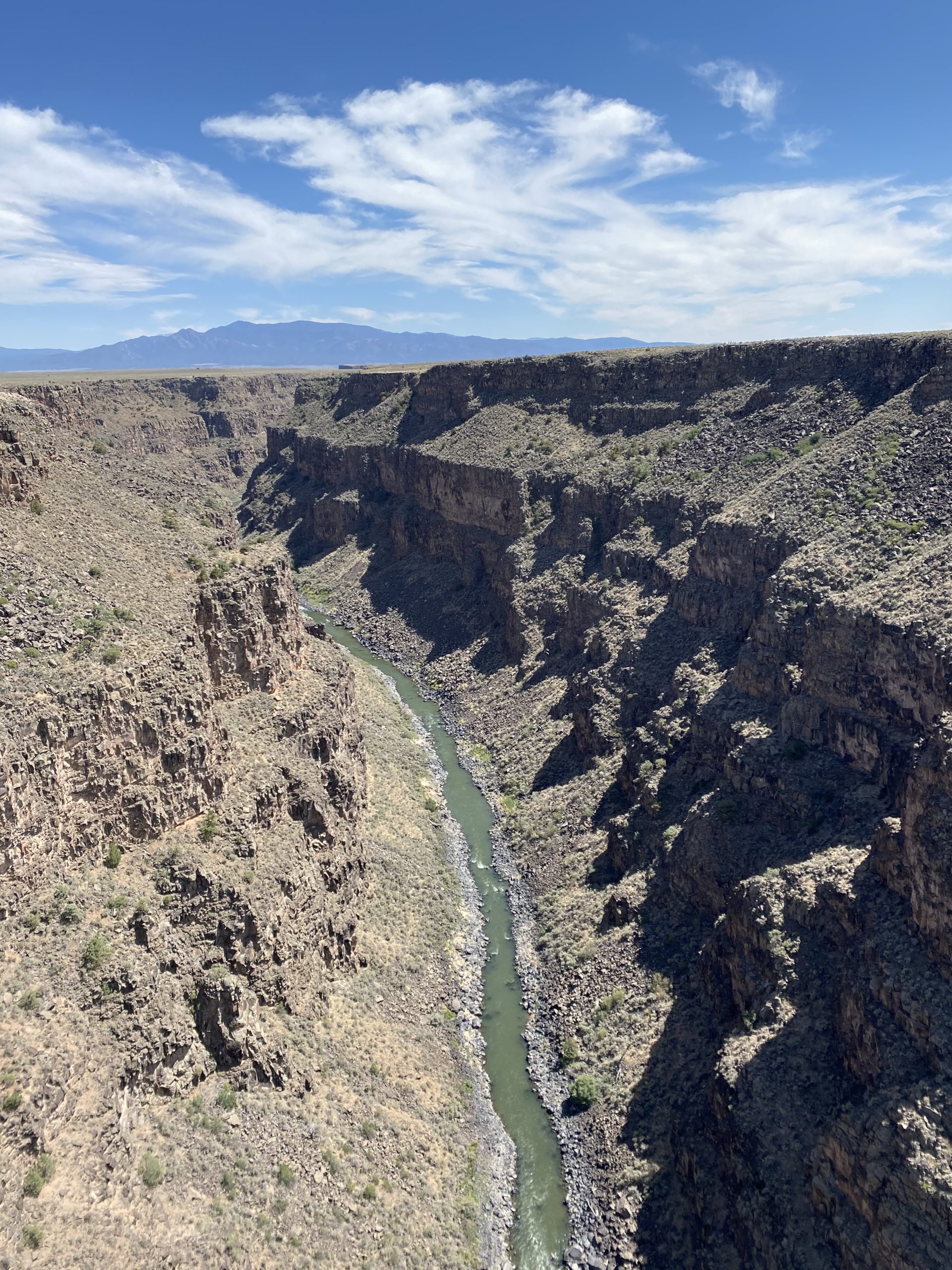
Understanding that all water is connected, whether above or below ground, is essential for successful water management. For instance, removal of surface water has the potential to deplete groundwater, and vice versa, resulting in impacts to recharge of both. The lawsuit between Texas and New Mexico that is heading through the United States Supreme Court regarding water use in the southern part of the state is a perfect example. Recharge into an aquifer is analogous to the many forms of recharge that occur in the human experience. Whether it is food and water for nourishment, clean air for respiration, or a deep conversation to satisfy our craving for human interaction, each of us requires various forms of recharge to sustain us. On a larger, often underappreciated temporal scale, these paths of recharge are the product of thousands of generations of life on Earth. This is similar to the evolution of the numerous aquifer systems across the world, each with unique recharge sources and relatively stable volumes of water that sustain their local ecosystems. The challenge for water managers is to identify, observe, and quantify these resources, while also characterizing the hydraulics of the aquifer, in an attempt to accurately predict the impacts of current and future use and reduce the likelihood of fully depleted aquifers.
Changes to the quality or quantity of recharge to an aquifer can have unintended and often detrimental consequences. Humans alter recharge sources through land development, sometimes resulting in contamination. Aquifers are being mined unsustainably with potentially irreversible consequences in the form of permanent aquifer compaction, also known as aquifer consolidation. Manifestations of mismanagement and poor decision making, typically driven by economic growth or limited data, impact the discharge points in watersheds where groundwater historically reemerged as surface water via springs and seeps. In New Mexico, surface water bodies such as rivers, springs, or wetlands are priceless and indispensable to the ecosystem. Increased storm intensity, earlier and faster snowmelt due to increased atmospheric heat, along with rain-on-snow events, are altering the ebb and flow of the hydrologic regime as we have come to know it. Water managers have their work cut out for them in this arid state with over-allocated watersheds, and interstate compacts governing allocation of rivers and streams.
Bringing it back to us — the assumption that we can carry on with business as usual, just like the notion our water supply is practically unlimited, is being challenged every day. Combine the coronavirus pandemic with the global competition for natural resources, a food system reliant on mass distribution of products transported long distances, and socio-political unrest — the result is that our personal recharge processes are being negatively impacted. Finding methods to fully process and cope with these realities is problematic, especially when our post-World War II societies are constructed around the pillars of consumerism and materialism, as opposed to sustainability, cooperation, and reliance on scientifically based management strategies. In an era of instant gratification, where a good portion of our youth are fixated on social media, and depression rates are skyrocketing, the sources of recharge associated with a healthy society are not clear or readily attainable. We are facing unprecedented challenges on an enormous scale, and the solutions required to face these challenges have yet to be agreed upon, primarily due to a lack of societal focus.
Education must be the answer, and education occurs best through dialogue. As long as the public remains disengaged from civic responsibilities and in the dark on issues that impact our existence — from clean water, clean air, and healthy soil to geo-political issues that define our “sense of security” —solutions will remain opaque, at best. Errors in management will be magnified, and daily routines and habits will persist. The divisions exposed and highlighted in the recent election cycle are symptomatic of 20th century governance and the pursuit of the self as opposed to the pursuit of a collective society focused on sharing limited resources. It is nearly impossible for constructive dialogue to occur when the parties involved are either talking over each other, or choosing not to listen.
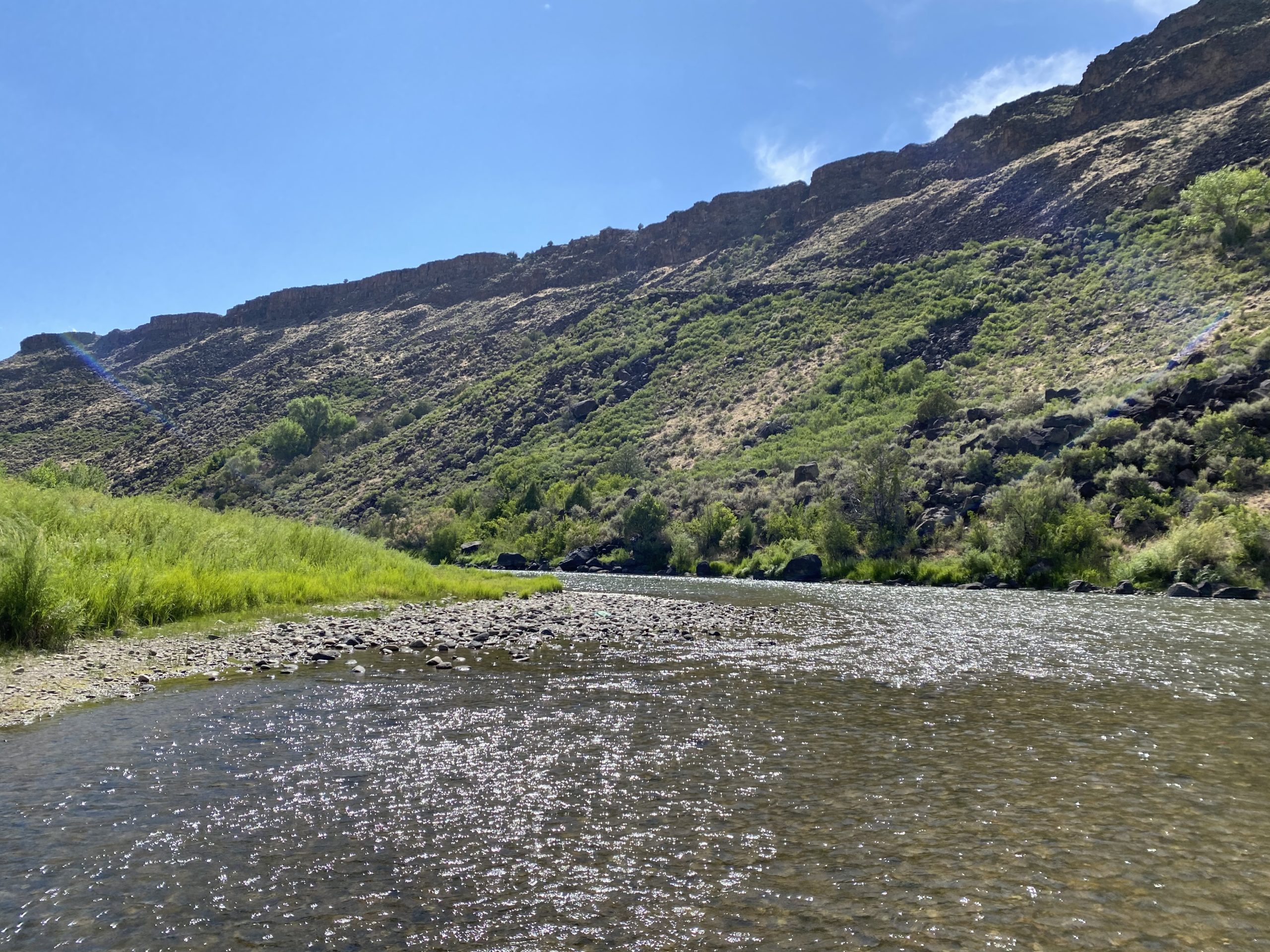
Fortunately, our species is highly resilient with the intelligence and capacity to solve imminent problems. Our scientists, economists, linguists, politicians, agriculturalists, etc. across the world have solutions. However, we are facing the momentum of intertwined industries invested in the status quo on scales that are hard to comprehend. As an example of interdependence and cooperation in the global community, nations from around the world came together in 1987 for the Montreal Protocol to protect the stratospheric ozone layer by phasing out the production and consumption of ozone-depleting substances. Private industries profited as research and development generated safe replacement technologies for chlorofluorocarbons and other detrimental products. In a similar vein, communities in New Mexico can come together to protect and secure our precious water resources for generations to come. The Governor’s push for a 50-year water plan offers the perfect opportunity for substantive dialogue.
I am thoroughly convinced there are implementable solutions to our problems, and in the long run, they may result in positive changes that make our current way of life unrecognizable. Our energy and transportation systems will change in order to reduce losses, increase resilience, and optimize delivery. A major investment in social and capital infrastructure is required on a scale that rivals the challenges we’re facing. The money required for this transformation exists in investments that are difficult, but not impossible, to redirect. Institutions across the United States have been divesting in funds associated with fossil fuels while investing in climate solutions. Perhaps it is time for our federal government to do something similar on a much larger scale.
Imagine a carbon neutral society in the near future driven by clean technologies, smart infrastructure, and sustainable agricultural practices. Our capacity for creativity is only limited by the problems we’re facing, and more importantly, our motivation. In the same way that scientists were able to weave together the stories of chlorofluorocarbons and the ozone layer, and the stories of surface water and groundwater, it is time for a new story about water in New Mexico — a story that intertwines science and sustainability, with community, cooperation, and thoughtfulness.
Water Resilience in New Mexico – Rolf Schmidt-Petersen
by Kathy Grassel
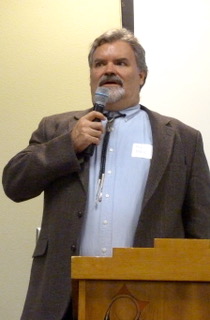
Director of the Interstate Stream Commission
Rolf Schmidt-Petersen thinks of resiliency as how far can you bend without breaking, and in New Mexico he has been impressed at both people’s and systems’ ability to bend. Schmidt-Petersen has been a familiar face in water circles for decades now, so he should know. Most recently, he was appointed by the governor to be the Director of the Interstate Stream Commission, while continuing as Colorado River Basin Manager that has been his job for the last three years. He began his talk remarking that everything he’d planned to say had already been said by the previous speakers. It was that kind of day. He complimented John Fleck on a good job describing the huge issues on the Colorado, Dave Gutzler on warming climate, and Darryl Vigil on tribal concerns.
Schmidt-Petersen referred to a news article in August of 2019 that had garnered a lot of attention. It was about water security risk in the world where New Mexico was ranked highest in the U.S., followed by California, Arizona, and Colorado. “The perception is in many parts of the U.S. and from my experience on the Colorado River that New Mexico doesn’t have its act together when it comes to water and has bigger problems than anyone else.” Schmidt-Petersen questioned this perception and asked the audience three questions. “What do you think about New Mexico from a water security standpoint on a statewide level? Are we in that situation? Highest water security risk in the US?” Lots of hands went up. “How about in your region? Do you feel that way about your region?” Fewer hands went up. “How about your local water supply?” Even fewer hands went up. “This is similar to the way I thought about that,” Schmidt-Petersen said. “Hey, I’m living in Santa Fe. They’ve been working on this water portfolio. They’ve invested huge amounts of money. I’m doing pretty good at my house. That got me thinking on the positive side of things in what I’ve seen in my 30 years of working in water in New Mexico.”
Schmidt-Petersen admires the Albuquerque Water Authority’s 100-year plan as visionary. “They’re putting their neck out and saying we’re going to use the water we have available to us now and we’re not going to go out and acquire pre-1907 water rights for offset while still meeting offset requirements.” He’s equally approving of Santa Fe with its $300 million investment in Buckman Direct Diversion among other initiatives—“a much more sustainable, diverse supply than existed 20 years ago when I moved there.” For the San Juan basin, he cites people and entities and programs that are looking out for their constituencies over the very long term. He compliments the San Juan Water Commission whose efforts are bringing a reliable surface water supply from reservoirs from Lake Nighthorse for the tri-city areas in the basin. The Navajo Nation is doing transformative projects related to the Navajo water rights settlement, Navajo-Gallup Water Supply Project, the Cutter lateral pipeline, Navajo-Gallup water pipeline, and the Eastern Navajo water pipeline on the other side. “There will be a ground-breaking and blessing ceremony for that pipeline within the next year or so,” he says. “That will significantly change the lifestyle of people throughout that entire area, many of whom have been hauling water for a long time.”
Schmidt-Petersen appreciates the cooperation of the Middle Rio Grande Conservancy District in ISC responsibilities to meet compact requirements. He says they have been very conservative in how they release water to try to meet multiple different needs, so that in the fall, if New Mexico is likely to be in a debit, they can release water from storage in order to reduce any accrued debit. “It’s partly in their interests to do that, but it’s also in the interest of the state and others for management flexibility throughout the Rio Grande.”
One measure of water stress is change is mean annual precipitation. Schmidt-Petersen showed a slide of a U.S. map subtracting the 25-year time period 1995-2019 of this most recent drought from the 25-year wet period of 1970 and 1994. What it shows is the Southwest bull’s-eye of dry. “Does that continue? Is it the new normal?” Numbers aside, Schmidt-Petersen credits certain people’s resiliency no matter what. “We have over 23 tribes and pueblos in NM and they’ve been here for well over a thousand years and they are resilient in how they go about using water and revere water. Same thing we heard about the acequias from Paula,” he says. “The thing that Phil said there that really struck me is the difference in expectations and characterizations of water between these two communities and those of the Lower Rio Grande, which is about production agriculture, commodification, and quantification.”
Schmidt-Petersen says he was struck by the fact that into July last summer there was no native Rio Grande water in the river. “If we didn’t have that San Juan Chama water, the Rio Grande would have been dry probably from San Felipe south,” he says. “It’s the San Juan Chama project that brings a portion of New Mexico’s upper Colorado River basin compact allocation into the Rio Grande. It’s been that extra little bit that’s made a difference.” That allocation is not something New Mexico can take for granted what with 40 million people being represented in the Colorado basin that are saying, hey, we’ve been cutting back, this system is getting really tight, shouldn’t these junior diversions be cut off? Schmidt-Petersen warns that the Bureau of Reclamation can’t guarantee that it will always divert that Colorado River water into the continental divide to Heron reservoir. “The way we’re protecting it is through the drought contingency plans that were signed into law after multiple years of negotiations,” he says. “The ISC had a pretty big role in that for the state of New Mexico. What they’re doing in the Lower Basin is incentivizing leaving water in Lake Mead for the water users in those areas to prop up the elevation of Lake Mead for both power generation and for long-term security for drought.” Schmidt-Petersen describes Drought Response Operations Agreements that are largely for power generation in the Lower Basin, but which is also a reliable, relatively cheap supply of energy for people across the four Upper Basin states, providing rural communities with that power.
Another part of the drought contingency plans applicable to the Upper Basin states is called a Demand Management Storage Agreement. Demand management is about conserving consumptive use of water in the Upper Basin, say, fallowing of irrigated land, proving that you did not consume water that you would otherwise have consumed in that year, translating that back to storage in the particular reservoir and then shepherding that water through the next states into Lake Powell, claiming that’s our water. According to Schmidt-Petersen, the purpose of that is to aid New Mexico if there’s ever a compact call under the 1922 Colorado River compact. “It’s a small risk but if we have those tools in place it gives the Upper Basin and each of the individual states much more flexibility and more tools to manage our destiny.”
Another issue out there: an explosion of oil production in the Permian basin and the demand for water for fracking going through the roof to the tune of 50,000 acre-feet a year in the region. “For the ISC that’s scary because we did a program to purchase water rights and retire lands in that area to get in compliance with the Pecos River compact and our deliveries,” Schmidt-Petersen says. “We have parties there that are resurrecting rights that 20 years ago we thought didn’t have any validity to them at all and now that have a need and a use for them.”
Endangered species also figure into ISC responsibilities. “From an ISC perspective, the way we’re looking at endangered species issues is from a value-based standpoint, from ecosystem services. They’re valued and something we need to protect and it’s part of doing business.”
Schmidt-Petersen moves on to water planning, where he says the message becomes somewhat mixed. The budget for planning in 2020 was $280,000 total, that “coming from one of our trust funds, meaning that we were taking money that we would have put on the ground someplace else and saying we’re dedicating that to planning,” he says. “The governor has been tremendously supportive of us and our request for support for larger planning for a 50-year plan. She’s also been supportive of providing funding to fill vacancies.” The other not-so-good piece of news was from the legislative finance committee recommendation that was 20 percent of the recommendation of the governor’s office. Still, Schmidt-Petersen looks at it as a glass half full. “We have the governor’s support for reducing vacancies. We have her support for moving forward on initiatives. On the legislative side,” he says, “we are not doing a good enough job of showing what the need is.”Meanwhile, many local communities continue dealing with the issues in front of them. It’s local solutions making a difference, with local people and entities doing needed projects on the ground. And, Schmidt-Petersen concludes, “when they value them, they stay.”
Emerging Policy Priorities – Melanie Stansbury
by Kathy Grassel
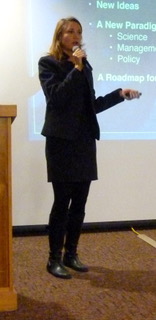
A new paradigm in water management is a big ask, but that’s exactly what state representative Melanie Stansbury believes has to happen, and she says people are ready for it. Stansbury, representative for House District 28 in the legislature, is already working on what she hopes will lead to a significant policy water reform package in 2021.
Stansbury sees the old paradigm that continues to dominate our landscape as what came with the settlement of the West after the 1840s: the prior appropriation doctrine, the creation of the Bureau of Reclamation at the turn of the century, and the building of physical infrastructure by the US government to capture water and move it around. Water management is still dependent on aging and outdated systems that include infrastructure, legal and policy frameworks, and how institutions are organized.
How to design for resilience? If solutions aren’t at hand, how do you build pathways to solutions? “We know the systems of the past will fail, and it’s very likely the systems we design in the future will fail as well,” Stansbury says. “So how do we design for failure creatively? How do we design flood control structures and water supply systems that when they do fail they don’t cause catastrophic problems for a community?”
If a paradigm is basically the set assumptions through which each of us perceives the world, Stansbury observes a new paradigm that’s been emerging for the last 30 years. “We understand that we can’t manage watersheds in isolation anymore. It’s one connected basin,” Stansbury says. “Not only is it connected hydrologically, it’s connected through human systems, the economy, and throughout our ecosystem.” Since the 1990s, “integrated water resource management” has been the effort to manage water as one water: drinking water, water quantity, ecosystem management all have to happen all together because it’s really one source of water. “It needs to be science-based, but I cannot tell you how difficult it is to harness the best available science,” she says. “When you look at a map of USGS’s surface water availability, for example, there are literally huge portions of the state that we don’t have data for. We’ve got to get our data and science house in order.”
Salisbury says that the challenge she’s had to face as a legislator is how to actually change the system itself and bring that paradigm into policy making. “One thing I learned in my seven years in Washington, D.C. with both some big wins and some big failures, is that if you don’t engage people on the ground and meet people where they’re at, both literally and figuratively, you are not going to change the system,” she says. “One thing I’ve been doing is holding listening sessions for the last six months all over the state attended by local people as well as from irrigation districts, utility managers, acequia majordomos, and state agency field staff who can tell us what can be improved at the headquarters level. I have heard all kinds of things I never thought of before, and they’re brilliant.” It’s obvious to Stansbury from these sessions that people are ready for changes to modernize past approaches to water management. For now, the managing agencies—the ISC, OSE, NMED, EMNR, Fish and Game—are riddled with unfilled vacancies. “We can’t start talking about big policy change until we have enough people actually in those seats.” Many programs are adequately funded, she’s learned, but with tons of vacancies the programs are not able to accomplish the key tasks a modern way. “There’s not a lot of communication and integration across these agencies. Does it make sense to integrate them somehow through statute so that it’s the default?” It is of course not as simple as that. “You can’t expect it to happen when your job is issuing permits over here or a legal document over there,” she says. “We’ve heard from both the public and within the agencies that many of the internal processes of the agencies are extremely onerous—everything from applying for permits to moving through any kind of formal process.”
As well as integrating agency functions, Stansbury would like to explore integrating funding. “We have all these different funds but right now they’re very difficult for communities to access. There are a lot of choke points in how we’re managing those. It should be possible to streamline and provide the ability to use all of the funds in the way that the Strategic Water Reserve imagines, which is that we would use money in the ways that it needs to be used.”
Integrating water resources management is another facet she heard much about in community settings; i.e., the desire to manage water quantity and water quality together. NMED which oversees water quality, both wastewater and drinking, and the OSE and ISC which are responsible for water quantity issues are not institutionally integrated at all. “There’s an increasing focus on the need to think about healthy rivers, streams, lakes, and ecosystems as part of our integrated water resources management,” she says, introducing the environmental exigencies that have been lacking in the old paradigm. It’s going to take some work. “NMED doesn’t have enough compliance officers issuing citations for violations. There are communities that have known things being dumped into their drinking water, but there’s nothing that can be done about it right now. That’s a crisis.” She cites rural communities that have known water problems but they by themselves do not have the capacity to design a sophisticated water treatment facility and then have operators operate it. “This is the whole point of government: Help people do things they can’t do on their own. We have technical assistance people who sit at state agencies, but they don’t fit together, and they are not able to provide this support,” Stansbury says. “Everyone who works on infrastructure, from the contractors to the engineers to the state agencies to the communities, sees this as one of the most fundamentally broken problems in the state. We really need to crack the nut on technical assistance.”
Stansbury is adamant about creating a science and data plan for the state and filling in the data gaps using the latest technology. She plants to ask for money for state agencies to upgrade their IT systems. “If any of you have ever gone on NMED or OSE websites to try to access data, you know exactly what I’m talking about. That’s going to cost millions of dollars to fix.” She’s also behind the governor’s plan to undertake a 50-year planning process as the next step beyond the state water plan. “The other reason we need a plan is because there’s tons of federal money out there and we never capture any of that because we don’t have our act together.”
Stansbury wants to get going, recognizing a huge opportunity for system change right now because we have executive and legislative branches that care about these issues and want to take action. However, she concludes, leadership from the people who sit in formal positions of authority won’t be enough. “If we’re going to bring a new paradigm in water management, we need you to get to work and show leadership in all the ways that you can in your communities, the people that you work with. You need to help people like me make that happen.”
